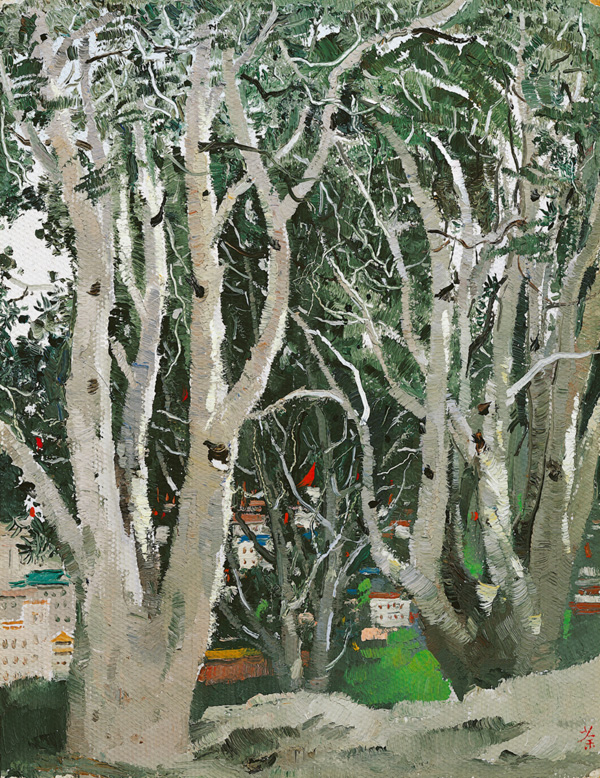ILLUSTRATED:
Su Zhai Collection 1991 Desk calendar, Hong Kong, color illustrated, March/April page
2006 Desk calendar, Yan Gallery, Hong Kong, 2006, color illustrated, November page
To be included in ¨The Complete Works of Wu Guanzhong〃 published by Hunan Fine Arts Publising House.
PROVENANCE:
Su Zhai collection, Hong Kong
Private collection, Hong Kong
Catalogue Note:
Transference of Formal Beauty
Text / Li Chiao
In his works of the 1970s, Wu Guanzhong already showed a lurking pursuit of a realistic painterly language. In other words, he attempted to find and realize a kind of formal beauty. Especially his subjects in landscape oil paintings are embedded with such vivid feelings. His painting of 1972, "Lacebard Pine", can serve as a good example. White-bark pine tree, a common kind of tree, becomes the principal subject for the painter as he observes nature. He captured and inserted the subject to form an artistic representation reflecting feelings through scenery. Colour tones of trees and the traced directions and shapes of trunks all arouse Wu's keen transferernce of formal beauty. Bearing such an idea in mind, he also played down architectural elements like houses and streets in his landscapes paintings so as to spotlight the spiritual nature of plants. As a result, the representation resulting from his colours and lines gained him a new status in the art field. Meanwhile, freedom and space for artistic representation were also obtained.
Based on his own traveling in the mountains and the nature for many years, Wu Guanzhong gradually accumulated rich experience in dealing with the artistic patterns of various kinds of trees. About this, his paintings contain changes of lines from traditional Chinese paintings and also have images constructed by interlocking and overlapping colours of Western art. Showing such mixed features of painting skills, "Lacebard Pine", as an art work with a highly-refined structure, would be a good example. The pine trees in the front site and the houses in the farther site are well-connected and act in coordination with each other. The spatial layers are abundant and structured-well-arranged, and dense but orderly. The key to this well-organized arrangement is his highly-generalized assembly of patterns and colours. The light-gray colour of the snow landscapes brings about a new chance for the representation of basic colours. Handling varieties of disorderly boughs of branches of the highly planed surfaces of such scenes, the space of nature is gradually far from variations, sophistications and trivial details of the objective subjects and is transferred into a tranquil and curtailed world in the painter's subjective concept. As a matter of fact, the reasons why the depiction of kinds of trees in nature becomes one of the subjects for artistic representation in which Wu specialized in his paintings are his unique understanding and sensitivity, his exquisite structures and proportions and his orderly assembling effects. Thus, in his paintings, an exceptional harmony between Chinese unrestrained transformations and Western expressionism can be found.
Wu is very much attracted by the natural creation of trees and flowers transferred into such a kind of humanistic landscape. To him there are possibilities of forms and variations provided while Chinese imagery becomes an often-seen artistic subject. Therefore, the painter's feelings for the whole humanistic environment of the above-mentioned landscapes inspired him in his creation of formalistic languages to use the element of traditional patterns of landscape paintings in oil to change classical contents. Then, he further transferred to a new method of structure and way of expression in his formalistic languages of oil paintings. With one step further, he practiced and deepened his ideas about his paintings and fulfilled the re-structuring of humanistic contents in patterns. As shown, he is able to infuse formalistic languages into his free-style painting experiences so that the traditional subjects for sketch are transferred into new creative subjects of combining patterns and colors. Also, a new structure of artistic languages is realized. No matter whether his painting subjects are urban views or natural landscapes, there are always subtly changing colours and lively brush work. Observing his painted houses and buildings, we can also notice that the contrast of horizontal and vertical overlapping gradual-upward straight lines and oblique lines yields abundant and orderly changes of rhythm. We also see that the sceneries generate their changes because of sunlight and shade as well as a contrast relationship being shown between coldness, warmth, purity and brightness of colors. Without any doubt, Wu was deeply immersed in such a delicate transitional process when creating his figurative and non-figurative painterly languages. He relied on all his painting, travel experiences and judgments to build his own structure with his own visual languages. The space for his poetic imaginings, in fact, offers Wu a kind of spiritual compensation in this material world. A deeper explanation is that, in the spatial structure of formal beauty, he delightfully supplies abundant possibilities of freedom for his creations.
All in all, Wu Guanzhong holds a Chinese pen brush for his creations on a piece of paper and is guided by modern Western artistic concepts. He uses Western-style oil to paint on canvas and is also influenced unobtrusively and imperceptibly by traditional Chinese experience of appreciating beauty. Viewers will easily sense Wu's whole-hearted pursuit and his efforts to bridge the two different approaches to painting of the East and the West.
